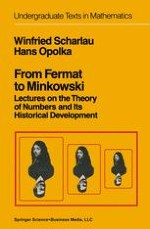This book arose from a course of lectures given by the first author during the winter term 1977/1978 at the University of Münster (West Germany). The course was primarily addressed to future high school teachers of mathematics; it was not meant as a systematic introduction to number theory but rather as a historically motivated invitation to the subject, designed to interest the audience in number-theoretical questions and developments. This is also the objective of this book, which is certainly not meant to replace any of the existing excellent texts in number theory. Our selection of topics and examples tries to show how, in the historical development, the investigation of obvious or natural questions has led to more and more comprehensive and profound theories, how again and again, surprising connections between seemingly unrelated problems were discovered, and how the introduction of new methods and concepts led to the solution of hitherto unassailable questions. All this means that we do not present the student with polished proofs (which in turn are the fruit of a long historical development); rather, we try to show how these theorems are the necessary consequences of natural questions. Two examples might illustrate our objectives.
